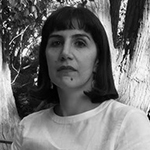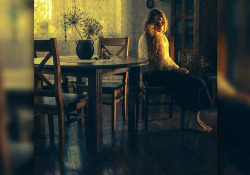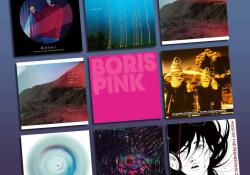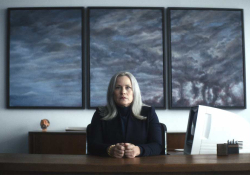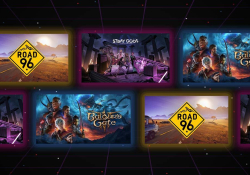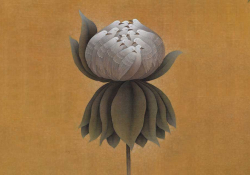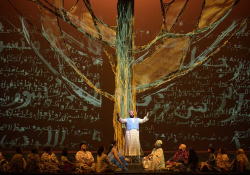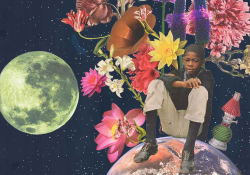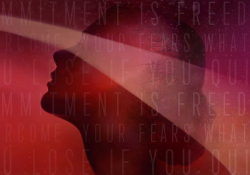On a Road of Grief: A Review of Hit the Road, by Panah Panahi
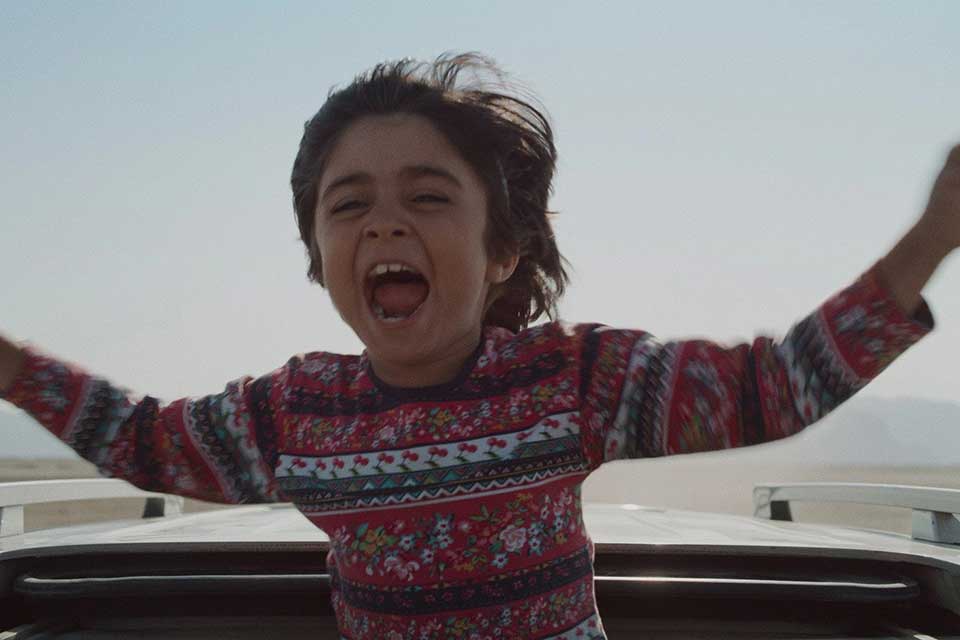
Editorial note: The following review includes spoilers.
Hit the Road (2021), Panah Panahi’s debut film, tells the story of a family of four on a road trip that is to change their lives in many ways. Mostly shot inside the car and focusing on the dynamics of the members of the family—the mother, the father, and the two sons—the film heavily relies on its characters/actors to share with the audience what they are going through on this journey. Keeping the reason for this trip a secret from the younger son and thus from the audience for as long as they can, the family is driving west to entrust the elder son into the hands of human traffickers so he can cross the border and leave the country. Even when we are let in on the secret, there are not many details spilled, because it is not the reasons, facts, and logistics of this departure that matter but rather the way each of these characters individually—and all of them together as a bonded unit—are dealing psychologically with this separation.
In a Zoom interview with Eugene Hernandez, New York Film Foundation director, Panahi speaks about not being interested in information and data, about not wanting to be a cultural messenger of life in Iran, and instead being drawn to “moods” and “emotions,” to characters and how they go through human experiences. That is what I want to do, too: start my review of the film by sharing the effect of the film and my own emotional experience with it.
I spent most of the film crying, eventually breaking down in sobs in my friend’s arms when the lights came on.
I watched the film twice, in the span of two weeks, both times at the theater. Once with a non-Iranian friend and the second time with an Iranian one. The first time ended up being so devastating that I spent most of the film crying, eventually breaking down in sobs in my friend’s arms when the lights came on. I spent much of my psychoanalysis sessions for the next few days discussing the film and trying to find out why it had such a deep impact on me. I needed to see it again, and I imagined the second time would be less heavy, as I knew what was awaiting me; well, yes, it was more manageable, but I still failed to stop the tears, perhaps even going through the emotions on a deeper level, the way one delves into different layers of trauma or any significant life event when revisiting them in therapy or analysis. The second time, I was the one who had to hold my friend in my arms so that she could calm down while the credits kept rolling on the screen.
Panahi talks in the same interview about his surprise at the film being so well received internationally. Inspired by some of his friends’ modes of leaving Iran, by his sister’s sudden departure following threats by the interrogator of their father, Jafar Panahi, as well as the desire and fantasies of many Iranians to build their future outside the borders of the country, Panah Panahi considered the work very “personal and local.” That is true for sure. As an Iranian, I and a large percentage of my friends and family have had to deal with the consequences of migration, whether we/they have left or are staying behind in Iran. My memory has gone blank about how, while growing up in Iran, my cousin left for Turkey, then Germany, and ultimately the US, in his teenage years in the 1980s, but I remember how we got together at his parents’ home awaiting his occasional phone calls and taking turns to chat with him for only a few seconds each. My memory has also completely erased scenes from my brother leaving Tehran to come the US; I remember the conversations and the decision-making, but the packing and saying goodbyes and going to the airport and all . . . they are nonexistent in my conscious memory. So, the film definitely felt personal to me. Panahi’s decision to remain with the family left behind, rather than with the person leaving, also brought to my mind painful images engraved in my memory of my parents and friends standing there waving goodbye the nights of my own departure flights from Tehran, when I emigrated, or in my many subsequent visits. All of us devastated and fragile, facing the many uncertainties awaiting us, trying to save face and yet failing.
By zooming in on this one family, this one car, by going very local and specific, Panahi succeeds in reaching a vast global audience.
But today, with more than 100 million people in the world displaced in the first few months of 2022, the subject of the film does not remain limited to the borders of Iran and Iranian families. Despite differences in departure locations, the reasons and specifics of journeys and destinations, one constant in all these situations is that families and communities get separated and dispersed all over, conditions that entail not only practical adjustments but also emotional burdens and losses no matter what is gained on the other side. The attention that Panahi pays to the most nuanced aspects of the family’s relationships and the manifestations of their personal internal conflicts in their demeanor allows him to create an intimacy between us, the viewers, regardless of where we come from, and his characters. By zooming in on this one family, this one car, by going very local and specific, Panahi succeeds in reaching a vast global audience, a success proven by the prizes and awards Hit the Road has won so far.
In his exploration of the family’s emotional landscape, Panahi relies extensively on music. From the film starting with the younger son’s fingers playing piano on keys drawn on the father’s broken leg’s cast, the parents singing a song by the late Iranian diva Hayedeh, the younger brother dancing in the car to a pop song by Shahram Shabpareh, to the younger son lip-syncing a song by Ebi, the chosen pop music of the film hits one hard. The songs, all from before the Islamic Revolution of 1979, are by Iranian singers who either live or have already died in exile; in addition to their bodies being banned from life in their home country, their songs, too, are legally banned in Iran. In defiance of all this, the emotional ties to these voices make them still widely popular, not only among the older generations but also the youth, with many who can afford the trips going across the border to neighboring countries to actually see them in concert. In my first viewing of the film, during the scene in which the parents sit in front of a shop, with a field and mountains in the background, sharing a moment of love and intimacy, murmuring to the music of Hayedeh playing in the car, I could not hold on to my tears anymore and broke down. Her voice in the theater sang, “Oh, you, who are my all / Without you my breath will come to a stop / If I have you, / I can reach whatever I wish.” Besides the complicated history and the meaning of these words, it was the mere fact of hearing her voice, loud and free, in a public space that made the impact much stronger, much deeper. In one of her interviews, Hayedeh talks about how one of her strongest fears is dying in exile, and this is exactly what happened: she died in 1990, at the age of forty-eight, in San Francisco and is buried in Los Angeles.
The songs, all from before the Islamic Revolution of 1979, are by Iranian singers who either live or have already died in exile; in addition to their bodies being banned from life in their home country, their songs, too, are legally banned in Iran.
Many of Panahi’s choices, whether narrative or aesthetic, are deeply symbolic and meaningful. From his characterization to the placement of the characters in the car, events, locations, and the role of the family dog, many of these choices can be further dug into from a psychoanalytical perspective.
The father figure is sitting in the back seat of the car, along with the younger son, while the elder son drives and the mother is in the passenger seat. The father, moreover, has limited mobility, because of his broken leg, which, as the mother notes in the night camp scene, also hinders him from using his hands (because of the crutches). The father also talks about having a toothache, which makes him wrap a scarf, one of the mother’s, around his face, for parts of the film. A pain in the mouth, impacting his ability to speak. The mother, in the front seat, is the one worrying about cell phones, eyeing the cars behind them, and thinking about logistics, trying to keep the mood light, even trying to dance while facing the elder son driving. Such representation of the father and the mother is important considering the fact that women, especially mothers, have been at the forefront of many social movements in Iran, an adamant force and voice fighting the crimes committed against their youths and themselves in the past few decades. Panahi also chooses for the elder’s son’s movements to be often slow and minimal, with him speaking very little, staring in front of him with an expression of shock and disbelief. The only moments we see him in a bit more action include a long shot of him and his brother running around and being playful on the lake with the dog, and later when he runs back to the car seeing the traffickers appear. The younger son’s energy and life-force translate not only to his cheerful language and constant talking and moving throughout the journey but also to his dancing in a scene on their way back from the border, with his head out of the car’s sunroof, while the mother’s and father’s movements are sedentary and contained inside the car, overshadowed by the pain they are hiding (the song they are dancing to, despite its dance and joyous tempo, speaks of separation and losing one’s life, a point Panahi has discussed). In an interview after his film screening at Cannes’ The Directors’ Fortnight (Quinzaine des Réalisateurs), Panahi talks about how the two sons are versions of himself: the younger being that of his childhood years, full of energy and hope, talkative and expressive, while the elder is his grown-up self, quiet and introverted, frustrated, and broken. In truth, the two are not just versions of Panahi but of many of us growing up in Iran, leaving or staying, our dreams of living a better future within the borders of our country, built through peaceful civil processes of reform, forever shattered.
In intimate moments before arriving at the village where they are to meet the traffickers, the mother and son share one cigarette with each other, with the mother putting hers on his lips; the father and son, later on, share one single apple, picked by the son from a tree and halved by the father, while sitting on rocks on a river. After the elder son departs, without the family really getting the chance to say a proper goodbye (but would there ever be one?), viewers then witness one-on-one moments between each of the parents and the younger son, the one left behind, moments that contain unmediated physical touch and embraces, for example, with the son lying on the father’s body the night of the brother’s departure, the boy hugging the mother the morning after, or the mother holding him on her shoulder and her back at the end.
Panahi’s choices of modes of expression of the pain of the son’s departure are also significant. The father can only half-cry in a semi-fantasy scene (paying homage to 2001: A Space Odyssey, the elder son’s favorite film of all time), wrapped in a coverall sleeping bag, with only his face showing, while the younger son lies on top of him. The two of them are staring at the sky and talking about Batman’s car, and it’s through this storytelling that the father can cry, pretending to be laughing or trying to stifle his emotions. With the mother, on the other hand, the expression is more direct. We hear her shout desperately, running in a long shot, when she realizes her son has left without a proper goodbye, and we see her, this time in close-up, hitting herself hard in the face while driving on their return journey, steering the remainder of their family back to Tehran in a borrowed car (because the mother’s is sold) to a house whose deed has been given up (though the details of this are not clear) and is not really theirs anymore.
In addition to the human characters, the dog plays an important symbolic role in the film. Dogs are a constant point of tension between Iranian people and the Iranian regime, given the extent of the limitations on the animals’ lives and freedoms (e.g., the permission for them to be walked in public or even be in cars, oftentimes a sign of the sociopolitical conditions of the time). The family dog is, moreover, a rescue dog, is ill, and mainly the younger son’s. The father was supposed to take him to the vet and put him to sleep, but he passed on that responsibility to someone else and the dog came back, to now accompany them on this journey. The well-being of the dog is one other thing on the minds of the parents, hidden from the younger son. When the dog becomes unresponsive and dies on their way back from the border, the younger son shrieks from fear and worry. Despite the parents doing all they can to sugarcoat reality and safeguard him from the brutality of loss, here he is receiving, shortly after his brother leaves, the first harsh blow, the first heavy loss of his life. The boy’s joyful dance and singing in the scene preceding this death translates into the boy’s listless body hanging over the mother’s shoulder while the father buries the beloved pet, and finally to the boy’s painful mouthing of the lyrics of Ebi’s song about leaving and staying, about pride in one’s land: “On this land / Oh, you, the noble man / You who were the one staying / You too have broken.”
One of the recurring, telling details of the film is the act of urinating and going to the bathroom. The very first scene of the film, though it starts with the interior of the car in the foreground, has, in the background, the elder son appearing from behind a mound, walking toward the car. As he gets to the car, he finds a bottle of water and uses it to wash his hands before drinking, a sign that he has just peed. A little while later in the same scene, it is the mother who disappears behind the mound and has the father pour some water on her hands to clean up after she comes back to the car. In another scene later on, the father takes the younger son to the restroom behind a store and waits for him outside. A memento that the mother has brought along to give the elder son to take with him is a small album, not of family pictures, but of pictures she took of traces of his peeing on sheets as a baby; as she browses these pictures, she comments on how this, representations of even his waste/refuse, could be considered artwork in a gallery on the other side of the border. Besides the family, there are two scenes in which the dog, too, needs to be taken, by the younger son, to pee. In a family trip, where the adults are struggling to hold so much inside of them, it seems as if these acts of urinating/defecating are one of the few outlets they have to relieve themselves of what they should not be carrying with them.
Another subject investigated throughout the film is that of lying and masking up. From the symbolic masks of happiness and fun times that the adults of the family try to wear to the real cloth masks the traffickers wear to the sheepskin that the travelers have to cover themselves with to cross the border, everyone is trying to hide something. This parallels the theme of surveillance, the fear of being followed, and with the cell phones being left behind or hidden. While the parents lie to make the upcoming separation easier for the younger son, they, as well as the elder son, are conflicted about what they are doing. The traffickers, too, perhaps in an attempt to make the final moments more bearable for the families, lie about the actual process of saying goodbye and separation. Even the cyclist they pick up along the path after an accident with their car (the realness of which one begins to wonder about in hindsight), who enters the frame with a song sung by the younger son about the honor of and pride in athletes, lies about being hurt only to get a ride from the family, to be dropped off much further along the path and get ahead of his fellow cyclists, to have more of a chance at winning the prize (none of this is articulated directly, only implied).
Everyone and everything is hurting. The land, the animal, the humans. They, we, are all wounded; they, we, are all mourning.
Meanwhile, one of the main geographical spots around which the journey takes place is Urmia (Orumieh) Lake, whose survival along with that of its wildlife has been under threat as a result of uneducated policies, corruption, lack of care, the imprisonment of environmentalists who do care and want to do something, and by global warming. On their way to the village where they are supposed to meet the traffickers, the father points to the lake and speaks about playing in its waters when he was growing up, adding that now it’s just dried up, to which the younger son responds, “Well, even better. You played with water; we play with dust.” In a scene while the mother and father are looking out from the side of the parked car, the two brothers play with the dog over a dried patch of lake, with a car passing behind them. Moments later, it’s their car that is driving, in the other direction, over the lake. Later on, it is here where the dog dies and is buried by the father, and the family forcibly lowers the veil of normalcy and expresses all the pain and frustration and grief they are feeling. Everyone and everything is hurting. The land, the animal, the humans. They, we, are all wounded; they, we, are all mourning. What complements and makes this environmental devastation even more heartbreaking is the younger son’s beautiful gestures of kneeling, as if in prayer, several times along the journey, to kiss the land and praise the beauty of God’s creation (an act that is made fun of, especially by the father), while the elder one is leaving this land behind to find life and beauty elsewhere.
Amidst all this pain, interwoven with the grief and loss, Panahi wisely and subtly attends to various manifestations of togetherness throughout the journey. Beyond the family unit, the love between the parents, and the bond between the brothers, someone has lent them a car, and there is supposedly a trusted friend of the father awaiting the son on the other side of the border. A male driver on the road warns them of the liquid leaking from their car, and a female driver assures them that it’s not gas but simply water from their air-conditioner. To get to the village, with the signs at a fork in the road broken and fallen, a minibus driver offers to help and guides them there. In the camp where the families of the departing boys gather, a mother and daughter come to help the mother and son get their things out of the car. For me, the most telling and beautiful reference to unity and people giving one another a hand, however, is in the scene where the family purchases sheepskin to be used by the son in his passage. When the father expresses concern that the skin they buy won’t get dry in time, the shepherd explains that each family buys the skin, not for themselves, but for the family coming after them; that their skin has already been bought by the previous passengers and is ready for them. The necessities of this journey toward freedom can only be passed on from one traveling group to the other. What one invests in will be ready to be used, not immediately, but by the ones coming after.
The necessities of this journey toward freedom can only be passed on from one traveling group to the other.
Skillfully, and with no grand, empty gestures, Panahi’s Hit the Road proclaims the psychological and emotional burdens a people carry in the face of loss, whether it be that of a beloved human or the nonhuman that defines them. It is also a testament to the fact that despite the brokenness, the younger generation, in the end, survives on the shoulders of its elders and raises their voice, and that the journey continues, in one direction or another, on one side or the other of the border, in one form or another.
Brooklyn, New York
